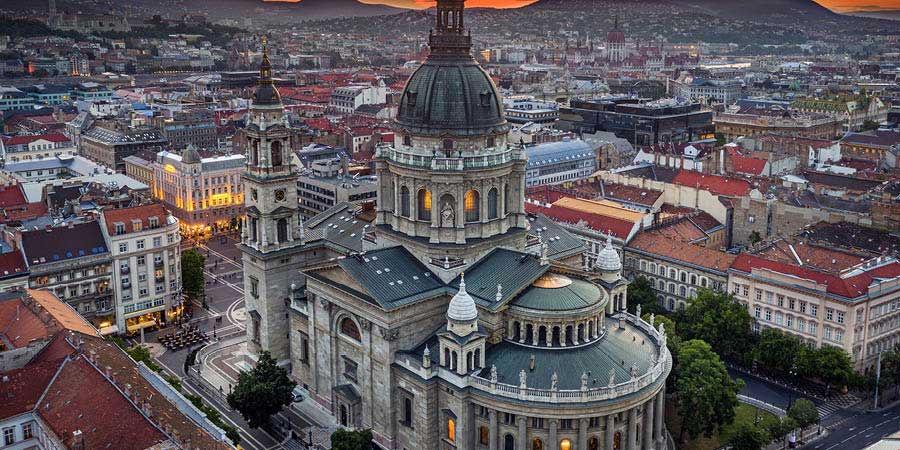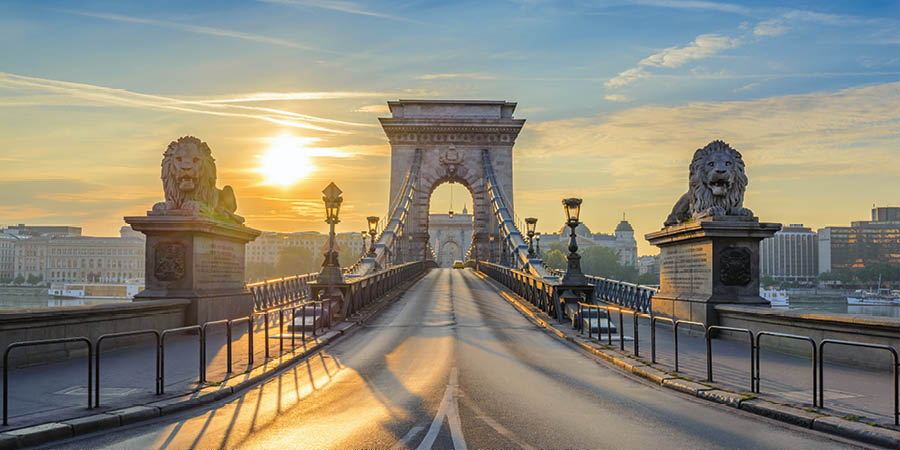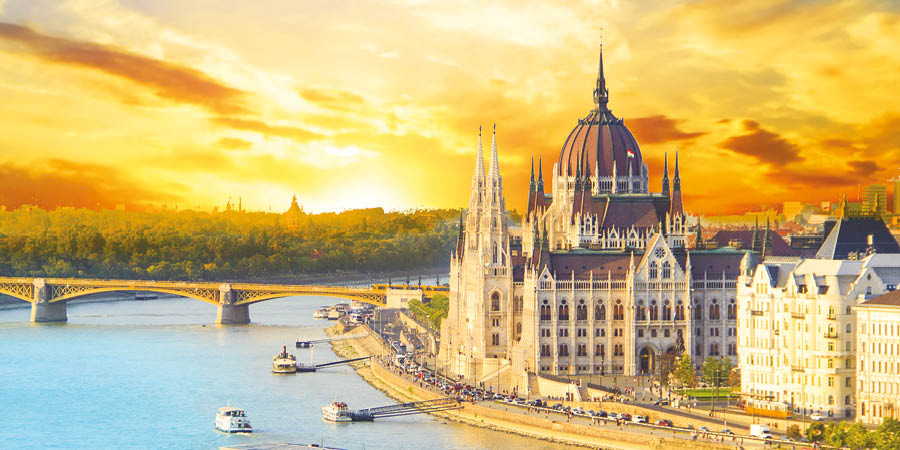It's hard to avoid Budapest when travelling in the vicinity, not just because all roads, rails and rivers lead there, but because it repeatedly draws in the return visitor.
Visit the 'Pearl of the Danube' once and you're likely hooked. Bisected by a gentle meander of the river, elegant, playful and historic Budapest really has something for everyone.

What's the history of Budapest?
Budapest has endured a complex but proud history of invasion and expansion since the Romans appeared in what was to become Pannonia in the 1st century AD and established the fortress town of Aquincum - the remains of which can be seen to the north of the city today. The Roman Empire wasn't the only one to take an interest in this part of Europe and the area around Budapest has been ruled by, amongst others, the Holy Roman, Byzantine, Mongol and Ottoman empires.
In between all this, the Magyars founded the Hungarian Kingdom in 896, a year that is mythologised in the country - so much so that St Stephen's Basilica and the Parliament building (representing religion and the state) are both 96-metres tall. However, it wasn't until the mid-19th century that the twin cities of Buda and Pest started to exert authority in the region. Lajos Kossuth and Sándor Petőfi are names that live on in street names and tree-shaded squares. The two revolutionaries met in Café Pilvax (which still exists on Pest's central Pilvax Köz) to plan the overthrow of the ruling Habsburg dynasty. The resulting Austrian-Hungarian Compromise of 1867 led to a dual-monarchy and the rapid growth of both Buda and Pest.
In 1873, the twin cities merged with the northern town of Óbuda to form Budapest, from then on an important and celebrated European city.
Hungarian history rarely stays stable for long and, over the following century, both fascist and communist regimes wrought their own terror on this remarkable city. The horrors of both are memorialised in the House of Terror Museum on Andrássy Avenue, which was used by both the Arrow Cross Party and the ÁVH secret police. The massacres committed by the fascist Arrow Cross are remembered in the form of a tear-jerking collection of iron shoes on the bank of the Danube to honour Jewish victims, while monumental statues from the communist period can be found in a fascinating and curious open-air museum called Memento Park in an unceremonious area on the edge of Budapest.

Top cultural attractions in Budapest
The Hungarian State Opera House's neoclassical exterior is beautiful enough, but its spellbinding interior is jaw-dropping and boasts some of the best acoustics in Europe. Formerly under the direction of Gustav Mahler, this remains a renowned location for fans of high culture. It's also on the UNESCO-listed Andrássy Avenue, a grand boulevard lined with spectacular mansions leading from the city centre to Heroes' Square (Hősök tere).
Overlooked by two neoclassical art galleries, Heroes' Square celebrates the millennium of Hungary's founding in 896 and contains statues honouring important figures from the country's history. Construction began in 1896, the year that saw the opening of the first metro line in continental Europe. Budapest's metro is the third oldest in the world, after London and Liverpool, and the tiled walls and wood panelling of the charming stations under Andrássy Avenue reflect this golden age for both Hungary and rail travel.
The reason Budapest needed a metro system was to transport residents to the centre of the millennium festivities in City Park (Városliget). This vast park contains more than green space. Vajdahunyad Castle is a recreation of several landmark buildings from different historical periods but does share many similarities with Corvin Castle in Transylvania - the former Hungarian region now in Romania.
In Budapest, the word 'culture' is regularly preceded by 'spa'. Fed by an underground cave system stretching beneath the city, the neo-Baroque Széchenyi Thermal Bath in the City Park is largest spa in Europe. The Romans enjoyed the benefits of the waters and even the hippos at the neighbouring zoo get to appreciate them. The ornate indoor and outdoor Széchenyi pools can be very popular during warm summer days, but Budapest has many others, including the Art Deco Gellért baths on the Buda side. Remember to pack your flip flops though!

Best places to visit in Budapest
A beautiful and vibrant city in its own right, it's hard not to focus on the majestic Danube when discussing Budapest's main attractions. Taking to the water is a great way to discover the fabulous architecture of the 'Pearl of the Danube'.
Hungary's stunning and symmetrical neo-Gothic Parliament building pierces the sky with white and red spires and enjoys pride of place beside the graceful river. As mesmerising at it is grand, the parliament (Országház in Hungarian) is regularly mentioned when the topic of world's most beautiful building arises. It looks even better when it's illuminated at night.
On the opposite bank of the Danube is Buda Castle, the historic centre of the Hungarian kingdom. Originally constructed in 1265, it was destroyed in 1686 when an alliance of European Christians retook the city from the Ottomans. A Baroque palace built by the Habsburgs was heavily damaged during World War Two, before being remodelled in a simplified style during the Soviet regime. While the hilltop streets surrounding the castle are picturesque, the 13th-century Matthias Church with its intricate Gothic decorations is the most significant church in Buda and contains an ecclesiastical art museum.
Behind Matthias Church are the smooth, flowing turrets of Fisherman's Bastion - one of Budapest's most popular attractions. This fairytale swirl of white stone was, like much of the city's finest architecture, constructed at the end of the 19th century and its seven turrets represent each Magyar tribe that settled in the area in 896. Not only is Fisherman's Bastion beautiful, stepping on to its parapets reveals iconic views of the parliament building across the Danube. The vistas from here are only matched from the top of St Stephen's Basilica in Pest. The viewing terrace of this stately neoclassical church can be reached by 302 steps - or 42 steps if you take the lift.
In the forested hills above Buda, you can find an utterly charming railway run by schoolchildren. Originally constructed as a way for children to learn the required skills to operate a railway, it is now a popular attraction for tourists. Children aged between 10 and 14 carry out all the roles, with the exception of train driver. Dressed in blue shirts and red caps, the children collect tickets and salute passing trains from stations, while the seven-mile route winds through beautiful forests of oak, beech and ash, occasionally giving way to reveal excellent views across Budapest.

Best places to eat in Budapest
Hungarian food occasionally suffers from the stereotypical view of central and eastern European cuisines, but, while it can be heartily rustic, it can also be elegantly refined.
One of Hungary's most globally renowned dishes in goulash, a delicious meat stew that is one of the country's national dishes. Hungary is proud of its association with paprika, and this delicate spice can be found in many of the country's most celebrated dishes, including goulash and - unsurprisingly given its name - chicken paprikash. The latter is best enjoyed with nokedli (small noodles like Germany's spätzle) and a side of refreshing cucumber salad made with liberal amounts of another Hungarian staple, sour cream.
You may see many people eating a disk of fried dough on the go. This is lángos, a surprisingly filling and popular Hungarian street food with roots dating back to medieval times. The classic topping is grated cheese and the ubiquitous sour cream.
While chimney cake (cooked on a spit) is a popular sweet treat and is actually Hungarian despite countless stalls selling it in cities such as Prague, Hungary benefited from its affiliation with Austria when it comes to cakes. Exquisite examples of delicious confections including dobos cake, Esterházy slice and sachertorte can be enjoyed in the grand surroundings of Café Gerbeaud. The opulent New York Café has been dubbed the world's most beautiful, and enjoying classic Hungarian cuisine amongst the elegant Italian Renaissance interiors has attracted influential visitors since it opened in 1894. Although do be prepared to queue as it is an understandably popular spot for brunch.
A legacy of the Romans arriving is the proliferation of excellent Hungarian wines that are enjoyed across the world today. From the sweet white Tokaji to the robust red Bikavér (or Bull's Blood), Hungary and especially Budapest is not short of excellent wine bars. The old Jewish Quarter gave rise to the phenomena of ruin bars, lively haunts in tumbledown buildings decorated with eclectic 'artworks'. The original is Szimpla Kert and it's a captivating place to wander round especially in late afternoon and early evening before the revellers arrive. However, when the weather is warm, there is nothing better than sitting down with a refreshing 'fröccs', a spritzer of white wine and soda water, overlooking the Danube.

Why Budapest is a great city to visit
This grand imperial city has something for everyone. From the high culture, museums and fascinating historical sites of Andrássy Avenue and Buda Castle to the vibrant nightlife and iconic ruin bars nestled among the history and architecture of the old Jewish Quarter - and, of course, the wonderful thermal spas.
With excellent shopping opportunities that you would expect from a capital, plus bustling markets selling local produce, and the glistening Danube flowing through the centre, Budapest is a captivating and enchanting destination whatever your interests.

Best time to go to Budapest
As with many European cities, Budapest appeals to different people at different times of year. Winters can be very cold and snowy, while the cherry blossoms burst into life on Margaret Island in spring. Summers are warm and often stretch through September, while the crowds thin out in autumn.
To see Budapest at its gleaming best, travel between May and September although slightly outside that period also has its benefits.
Visit Budapest with Great Rail Journeys on the following tours:





